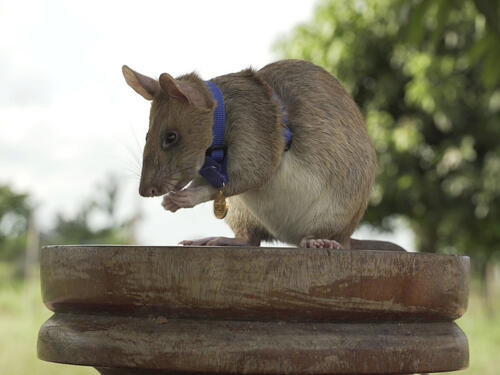Giant Rat Receives Tiny Medal for Life-saving Work in Cambodia

Giant Rat Receives Tiny Medal for Life-saving Work in Cambodia
“What the…” was the response I received from my mother when I shared this headline: “Giant rat earns animal hero award for sniffing out landmines in Cambodia”. Although my own initial reaction was to chuckle, thinking about this story in the broader context of modern Southeast Asia actually proved intriguing. Prominent in all articles on the subject is a picture of the rat in question, Magawa. This African giant pouched rat, born in Tanzania, was trained by the Belgian nonprofit APOPO as part of its “HeroRAT Initiative”.
In several countries, including Cambodia, Vietnam, Laos, and Thailand, APOPO has deployed trained rats to detect landmines and other explosives using their powerful sense of smell. Notably, what warranted news coverage was not the ongoing problem itself, or the work of APOPO, or Magawa’s Cambodian handlers. Instead, it was the fact that, for the first time, a rat was honored with a gold medal from the People’s Dispensary for Sick Animals. This U.K. charity commended Magawa for his “dedication, skill and bravery”. There is something inherently charming about the concept of this HeroRAT; the image of him sitting proudly on a tree stump with his tiny gold medal stands in stark contrast to much of the news we receive. Nevertheless, we must place Magawa in a wider context. The importance, and historical basis, for APOPO’s work in Cambodia is outlined by Anna Schaverien for the New York Times:
More than five million land mines are thought to have been laid in Cambodia during the ousting of the Khmer Rouge and internal conflicts in the 1980s and 1990s. Parts of the country are also littered with unexploded ordnance dropped in United States airstrikes during the Vietnam War, a 2019 report from the Congressional Research Service found.
Since 1979, more than 64,000 people have been injured by land mines and other explosives in Cambodia, and more than 25,000 amputees have been recorded there, according to the HALO Trust, the world’s largest humanitarian land mine clearance charity.
Born in Tanzania and employed in Cambodia, trained and transported by a Belgian NGO and awarded by a British charity, and achieving international fame through global news outlets: Magawa is undeniably a product of globalization. The landmines which he is tasked with discovering are also deadly reminders of how past and present are inextricably linked. For many in Cambodia, including Magawa’s handler So Malen, the ongoing legacies of war have been experienced firsthand. But in the minds of many foreign readers, amused or repulsed by the image of this HeroRAT, history has moved on. Like many world powers, the U.S. is often criticized for leaving behind messes for others to clean up. In this case, consequences of American foreign policy also led to the story of a decorated giant rat. “What the…” is an apt response.
References:
https://www.npr.org/2020/09/25/916892377/hero-rat-wins-a-top-animal-award-for-sniffing-out-landmines
https://www.nytimes.com/2020/09/25/world/europe/giant-rat-magawa-medal.html
https://www.apopo.org/en/what-we-do/detecting-landmines-and-explosives
https://www.apopo.org/en/latest/2018/01/Paving-the-way-For-Women-In-Cambodia
Comments
Jarron! What a smart and interesting multilayered post. This is a far cry from the history of hygiene campains in SE Asia when villagers could win prizes for rat catching. (Most rat tails collected would win a prize). For an example, check out this post about Singapore in 1820, or this book about colonial Hanoi: The Great Hanoi Rat Hunt: Empire, Disease, and Modernity in French Colonial Vietnam.
But the real story you are highlighting–about UXO (unexploded ordinance)–is indeed a dark legacy of the Indochina conflicts. In addition to landmines, there were intense legacies of bombing, which Yale’s Ben Kiernan has documented here: https://gsp.yale.edu/case-studies/cambodian-genocide-program/us-involvem…
and which is really well visualized here at this GIS mapping website: https://www.esri.com/en-us/maps-we-love/gallery/vietnam-bombing.
Jarron, when I glanced at this article in the NYT I was hoping someone in this class would write about this, yes! I really enjoyed your writing here, especially how you draw out the possible range of affective responses alongside delving into the transnational implications of the efforts to hero this rat and their surrounding histories. There’s also been an interest in turning to the play between the human/nonhuman in Anthropology that I can imagine would be another angle to look at HeroRAT from. Great job!
Pages